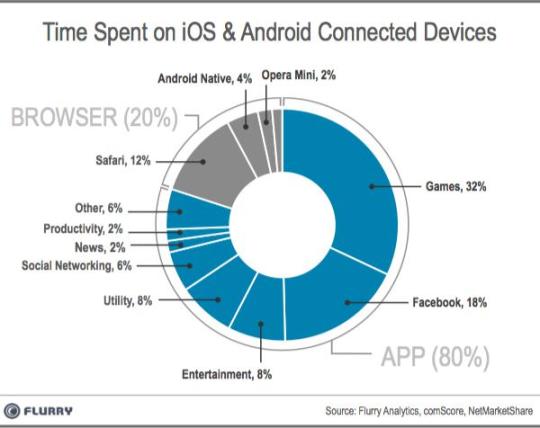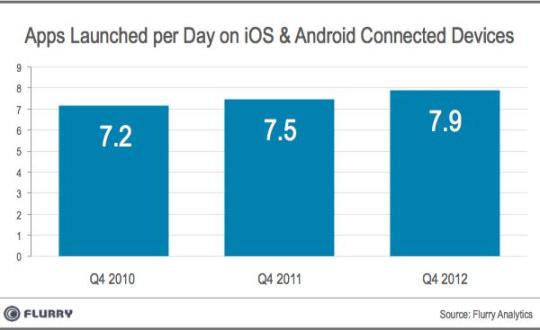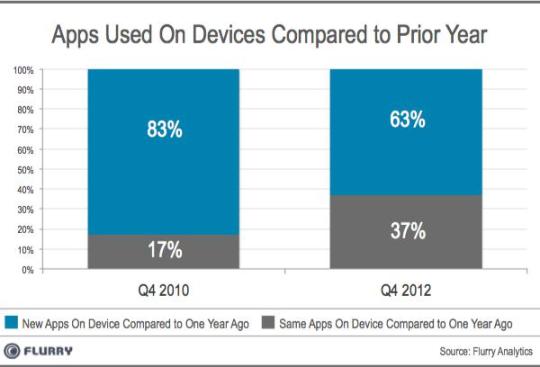Five years ago, the iPhone ushered in the era of mobile computing. Today, more than a billion consumers are “glued” to these devices and their applications, impacting nearly every aspect of their lives. For businesses, opportunities seem endless and disruption is everywhere. The list of disrupted industries is long, including communications, media and entertainment, logistics, education and healthcare, just to name a few.
The past five years at Flurry have been wildly exciting. We joined an industry just as gas was forming to ignite a Big Bang, and we’re still orienting ourselves within its rapidly expanding universe. Since early 2008, we’ve worked with tens of thousands of developers to integrate our analytics and ad platforms into their apps. Today our services have been added to more than 300,000 applications and we measure usage on more than 1 billion monthly active smart devices.
On the five-year anniversary of launching Flurry Analytics, we took some time to reflect on the industry and share some insights. First, we studied the time U.S. consumers spend between mobile apps and mobile browsers, as well as within mobile app categories. Let’s take a look.

Today, the U.S. consumer spends an average of 2 hours and 38 minutes per day on smartphones and tablets. 80% of that time (2 hours and 7 minutes) is spent inside apps and 20% (31 minutes) is spent on the mobile web. Studying the chart shows that apps (and Facebook) are commanding a meaningful amount of consumers’ time. All mobile browsers combined, which we now consider apps, control 20% of consumers’ time. Gaming apps remain the largest category of all apps with 32% of time spent. Facebook is second with 18%, and Safari is 3rd with 12% Worth noting is that a lot of people are consuming web content from inside the Facebook app. For example, when a Facebook user clicks on a friend’s link or article, that content is shown inside its web view without launching a native web browser (e.g., Safari, Android or Chrome), which keeps the user in the app. So if we return to the chart and consider the proportion of Facebook app usage that is within their web view (aka browser), then we can assert that Facebook has become the most adopted browser in terms of consumer time spent.
Five years into its existence, the app economy is thriving, with The Wall Street Journal recently estimating annual revenue of $25 billion. Once again, we have to appreciate that this economy did not exist until 2008. As we looked for possible signs of slowing, we could not find any, largely due to the fast adoption of tablets just after smartphones.
In fact, not only is the installed base of devices growing, but also the number of apps consumers use. Our next insight comes from studying how many apps the average consumer launches each day. For this snapshot, we compared three years of worldwide data, taking the 4th quarters of 2010, 2011 and 2012.

From left to right, we see that the average number of apps launched per day by consumers climbs from 7.2 in 2010 to 7.5 in 2011 and finally to 7.9 in 2012. This is not a material change, which is a good thing. To us, the steady growth rate indicates that the app economy is not yet experiencing saturation, as consumers steadily use more apps over time. And while there are more apps in the store, large numbers of them have short lifespans, such as books, shows and games. Assertions that people are using fewer apps in 2012 than they did in 2010 appear to be incorrect. While one could observe that consumers use only 8 apps per day among the million+ available between the AppStore and Google Play, one also needs to remember that the 8 apps each consumer uses varies widely. This creates a marketplace that can support diversified apps.
Finally, we studied a sample of more than 2.2 million devices that have been active for more than 2 years to understand the mix of new versus existing apps people use over time. To do so, we compared Q4 2012 to Q4 2010.

The chart above shows that, on average, only 17% of the apps used in Q4 2010 were in use earlier in the year on a device compared to 37% in Q4 2012. That means that 63% of the apps used in Q4 2012 were new, and most likely not even developed in 2011 (or possibly poorly adopted). We believe that with consumers continuing to try so many new apps, the app market is still in early stages and there remains room for innovation as well as breakthrough new applications.
Looking again at the first chart in this study, while also considering the latest numbers from IDC, which projects that tablets will outsell desktops this year and notebooks next year, we draw the conclusion that the web, as we know it, is already facing a serious challenge. Does this mean the web is dead? We don’t believe so. On the contrary, we believe that the web will change and adapt to the reality of smartphones and tablets. Websites will look and behave more like apps. Websites will be optimized for user experience first and search engine optimization second. This supports the trend of mobile first and web second, which brings both mobile app and user experience design to the mobile web. Simply compare Target’s app on iPhone to its mobile web site (target.com) accessed from the iPhone. The mobile web site looks and behaves similarly to the Target app, albeit a little bit slower.
Continuing to think about the first chart, it appears that mobile, once perceived as Facebook’s Achilles’ heel, has become Facebook’s biggest opportunity. Consumers are spending an average of nearly 30 minutes per day on Facebook. Add to that Facebook’s massive reach, as well as their roughly billion mobile users per month and you have a sizable mobile black hole sucking up peoples’ time. The 30 minutes a day is a worldwide average which means a large group spends even more time on Facebook (possibly hours) watching and participating in what has become the ultimate reality show in which the actors are you and your friends.
The disruptive force of the mobile app economy has created opportunities, rising stars, instant millionaires, dinosaurs and plenty of confusion. However, one undeniable truth is that tablets and smartphones are eating up desktops, and notebooks and apps (including the Facebook app) are eating up the web and peoples’ time.